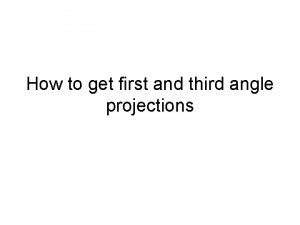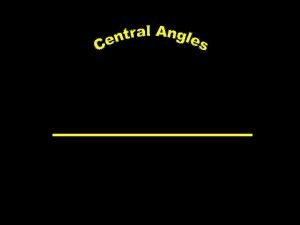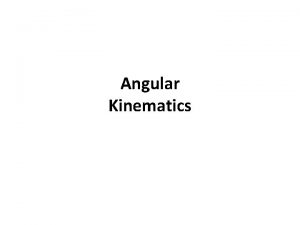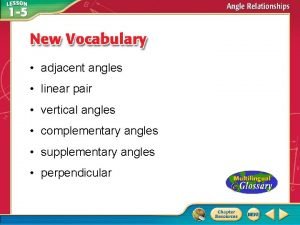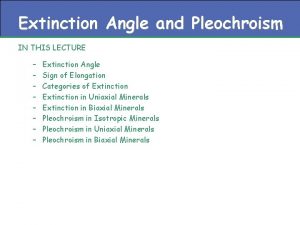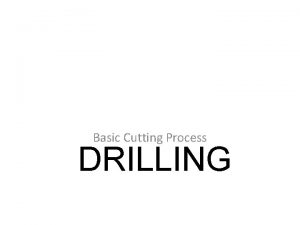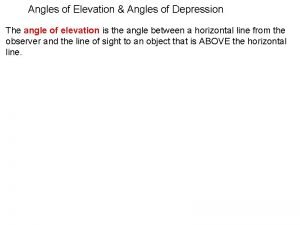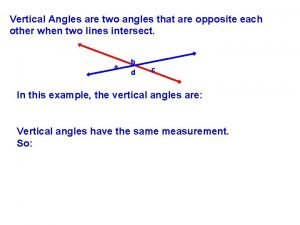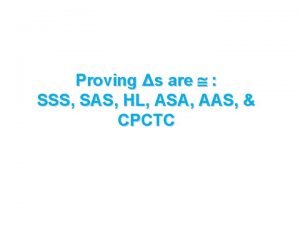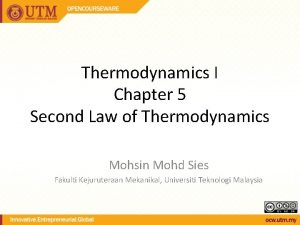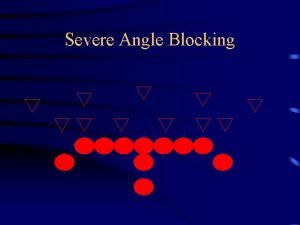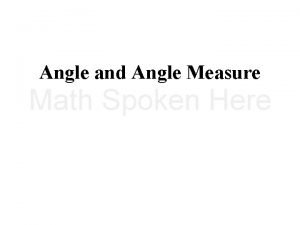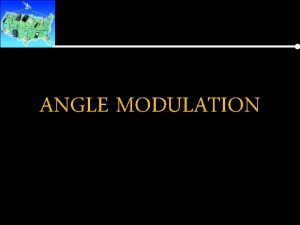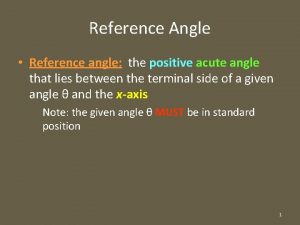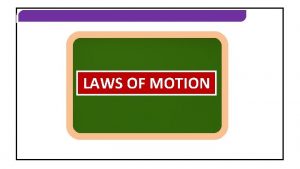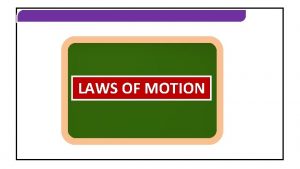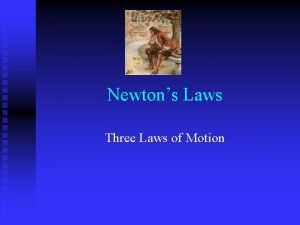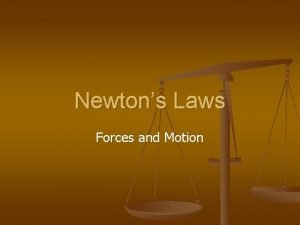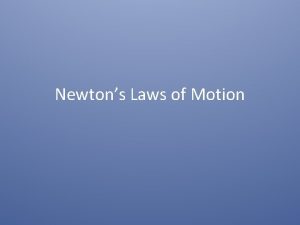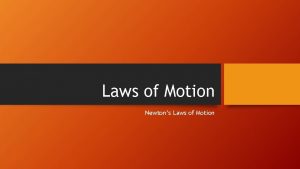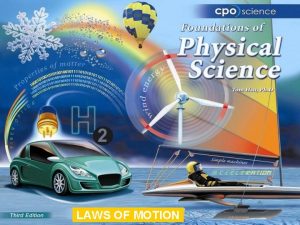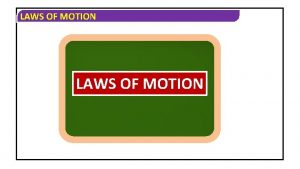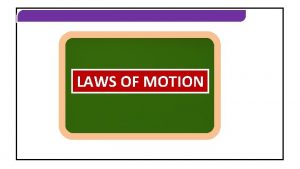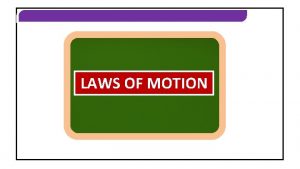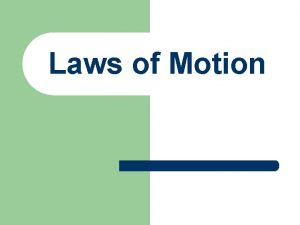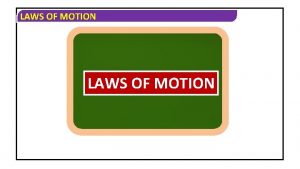LAWS OF MOTION LAWS OF MOTION ANGLE OF




















- Slides: 20

LAWS OF MOTION

LAWS OF MOTION ANGLE OF FRICTION ( )

LAWS OF MOTION C Angle of friction( ) A R B Ø The angle made by the resultant of the normal reaction and the limiting friction with normal reaction is called angle of friction ( ). N f. L O Mg Ø Suppose a block of mass ‘m’ is on a rough horizontal surface. The body is experiencing the limiting frictional force (f. L) under the action of applied force (F).

LAWS OF MOTION Ø Let N be the normal reaction acting on the block and R be the resultant of normal reaction and frictional force. Ø In the above figure OA represents N, OB represents f. L. Completing the parallelogram OACB, OC gives the resultant of N and f. L. C A In OAC R B N f. L O Mg

LAWS OF MOTION C A R B f. L N O P Mg Ø The greater the angle of friction the greater is the value of co-efficient of friction.

LAWS OF MOTION 1) The greater the ______greater is the value of co-efficient of friction. a) angle of repose b) critical angle c) angle of friction d) none of these MCQS

LAWS OF MOTION 2) The angle of friction = _______. a) tan-1 k b) tan-1 s c) tan-1 r d) sin-1 s

LAWS OF MOTION OF A BODY ON A ROUGH HORIZONTAL PLANE

LAWS OF MOTION I. Motion of a body on a rough horizontal surface Ø Consider a rough horizontal surface on which a block of mass ‘m’ is placed. f. K a P Ø Let a force P which is greater than the limiting frictional force applied on the body to move it towards right against friction. Ø Here kinetic friction f. K will act on the body. Ø Let a be the acceleration of the body then the net force acting on the body.

LAWS OF MOTION N a P f. K mg Ø If ‘N’ is the normal reaction , from the laws of friction fk = k. N = kmg Ø If the acceleration produced is ‘a’, the resultant force

LAWS OF MOTION F = P - fk ma = P - fk or a = (1) Ø Using eq-1, the distance (S) moved in a given time ‘t’ and the velocity acquired can be calculated with the help of kinematic equations of motion.

LAWS OF MOTION OF A BODY ON ROUGH INCLINED PLANE

LAWS OF MOTION Motion of a body on rough inclined plane Ø The plane which makes an angle with the horizontal is called inclined plane. Ø Consider a body of mass ‘m’ placed on a rough inclined plane which makes an angle with the horizontal. Ø When an applied force acts on the body, frictional force comes into play, if it exceeds the limiting friction, then the body is ready to slide.

LAWS OF MOTION N sin mg f mg mg cos v The forces acting on the body are a) weight(mg) acting vertically downwards. It is resolved into two components. The component mgcos normal to the inclined plane and the component mgsin parallel to the inclined plane.

LAWS OF MOTION b) Normal reaction N perpendicular to the plane. c) Frictional force (f) in the upward direction parallel to the inclined plane. Ø If the body is at rest on the inclined plane, mgsin balances the static friction, the normal reaction of the plane N on the block is balanced by mgcos. f = mg sin , N = mg cos

LAWS OF MOTION ANGLE OF REPOSE ( )

LAWS OF MOTION Angle of repose( ) Ø The angle of repose is defined as the angle of inclined plane at which a body placed on it just begins to slide. N in s g m P mg f. L mg cos Equilibrium on an inclined plane Ø Angle of repose doesn’t depend on the mass of the object as well as its area of contact. Ø But it depends on relative smoothness of the surfaces in contact. For a given pair of surfaces the angle of repose remains constant.

LAWS OF MOTION Ø Let us consider a block of mass m, at rest on an inclined plane, which makes an angle in limiting equilibrium with the horizontal N as shown in figure. P Ø The forces acting on the body are 1. Weight of the body ‘mg’ acting vertically downwards, m in s g mg f. L mg cos 2. Normal reaction ‘N’ acting perpendicular to the inclined plane. 3. Force of limiting friction f. L acting tangentially to the inclined plane.

LAWS OF MOTION Ø The weight of the body is resolved into two rectangular components. i. mg cos perpendicular to the inclined plane, ii. mg sin parallel to the inclined plane downwards, where ‘ ’ is the angle of repose.

LAWS OF MOTION Thank you…
 Charles de secondat
Charles de secondat Aa similarity postulate
Aa similarity postulate Critical angle formula
Critical angle formula System of orthographic projection
System of orthographic projection Angle whose vertex is at the center
Angle whose vertex is at the center Site:slidetodoc.com
Site:slidetodoc.com Absolute angle vs relative angle
Absolute angle vs relative angle Two vertical angles
Two vertical angles Name an angle adjacent to angle fgi
Name an angle adjacent to angle fgi Angle klm and angle mln are complementary
Angle klm and angle mln are complementary Angle addition and angle bisector worksheet
Angle addition and angle bisector worksheet Segment bisector postulate
Segment bisector postulate Symmetrical extinction
Symmetrical extinction Angle 1 and angle 2 are supplementary
Angle 1 and angle 2 are supplementary Center drill definition
Center drill definition Angle of elevation and angle of depression word problems
Angle of elevation and angle of depression word problems Are 3 and 6 vertical angles yes or no
Are 3 and 6 vertical angles yes or no Vertical triangles theorem
Vertical triangles theorem Acute angle right angle
Acute angle right angle 3rd angle orthographic projection
3rd angle orthographic projection Perpetual motion machine
Perpetual motion machine



